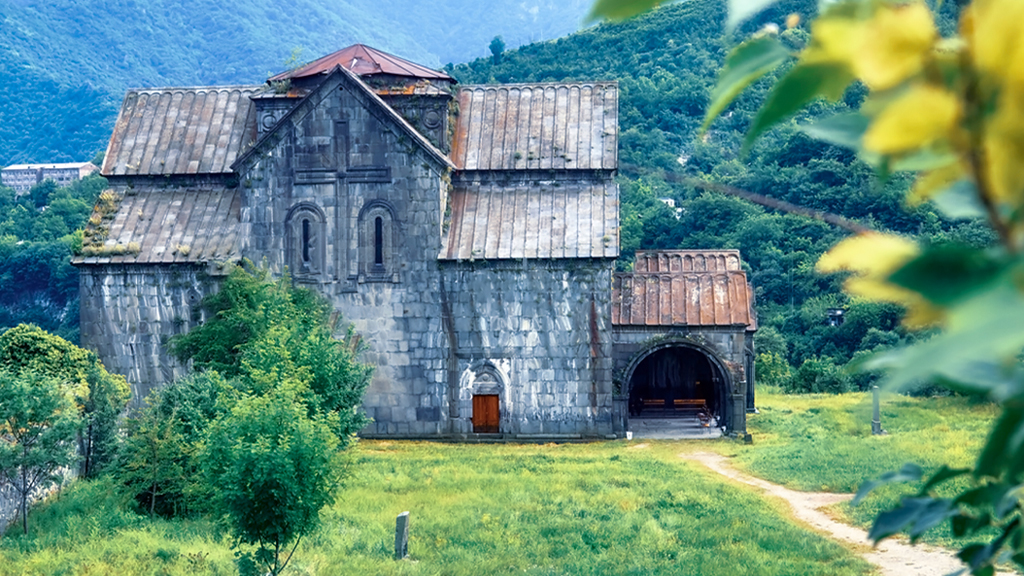ARMENIA
ARCHAEOLOGICAL AND MEDIEVAL ARMENIA
9 days / 8 nights
(May - October)

Day 1: Arrival in Armenia
Landing in Yerevan. Meeting with the local guide after passing the passport control. Transfer by coach to the hotel and accomodation in reserved rooms. Resting. –/–/–
Day 2 : The birth of Yerevan
The second day is dedicated to two of the archaeological sites of the city of Yerevan: Arin Berd and Karmir Blur. Visiting the Museum – Erebuni Historical and Archaeological Reserve which is located at the Urartean fortress of Erebuni in Yerevan, the Armenian capital. It presents objects found during the archaeological excavations of the site as well as in the Urartean fortress of Teishebani and in the place of Shengavit. Teishebani is an ancient fortress of the kingdom of Urartu. It corresponds to the current place of Karmir Blur near Erevan. It was built by King Russa II in the first quarter of the 7th century BC and is located in a few kilometres to the south-east. Overnight at the hotel. B/L/–
Day 3: On the slope of Biblical Moutain Ararat
After breakfast, leaving for the Ararat region, visiting Khor Virap and the archaeological site of Dvin. The fortified Monastery of KhorVirap (13th -17th centuries), called the “Deep Pit”, preserves the underground cell of Saint Gregory, imprisoned by the will of King Tiridate and freed after 13 years before converting to Christianity. After we visit Dvin. The city was founded by Khosrov II in 335 BC, became the capital, seat of the Arshakunì dynasty and patriarchal seat of the Armenian Catholicosate. Cultural and commercial centre of great international reknown, Dvin was conquered by the Arabs in 640 AD. It remained a lively and prosperous city until the reign of Bagratids, in spite of frequent earthquakes. Only in 1236, after the conquest by the Mongols, it was definitively destroyed and abandoned. We will continue towards the monastic complex of Noravank (13th -14th century), a UNESCO heritage site, mainly built by the famous architect and monk Momik, embellished with superb bas-reliefs. Before lunch, we will visit the Birds Cave where the oldest shoe and the oldest cellar in the world (6000 years BC) were found.Overnight at the hotel. B/L/–
Day 4: On the Silk Road of Marco Polo
After breakfast, leaving for the Vayots Dzor region and set off towards Lake Sevan, crossing the Selim pass at 2410 m above the sea level. Departure for the Selim Pass along the Geghama Mountains. Stopping and visiting the Selim Caravanserai. Stopping on the main road which goes through the mountains. Caravanserai of Selim (13th century) has offered hospitality to countless travellers and it is one of the best preserved in Armenia. Going on to the village of Noraduz and his medieval cemetery full of khatchkars disseminated all over the shore of Lake Sevan (more than a thousand can be counted). The day ends with visiting Lake Sevan and the monastery located on the peninsula. You can admire beautiful khatchkar (engraved memorial stones typical to Armenian Christian art) adjacent to the religious buildings. Overnight at the hotel. B/L/–
Day 5: North of Armenia
Leaving for the region of Alaverdi. After about 2 – hours’ drive you will get and visit the Basilica of Odzun which dates to the end of the 6th century. The Funeral Monument (5th -6th centuries) represents 3 pillars and a 4-sided stele of relieves and ornaments in 2 arches tells us about the adoption of Christianity in Armenia. There is the beautiful monasterial complex of Haghbat in the same region, which is listed in a UNESCO Heritage Site. Afterwards, you cross the gorge of the river Debet, visit the Akhtala Monastery, immersed in a fantastic scenery. Overnight at the hotel. B/L/–
Day 6: From Antiquity to Medieval Fortresses
After breakfast, leaving to discover antiquity, visiting the remains of the Agarak site and its surroundings which are entirely covered with gigantic complexes of stone caves structures dating to the Early Bronze Age. Afterwards you will go on towards the architectural and historical complex of Ashotsk which is composed of a 5th century church, was rebuilt in the 19th century and of a 4th century crypt where the kings Arshacids (Arshakuni) rest. The day ends with a visit to the medieval fortress of Amberd of the 7th century at the intersection of the Arkashen and Amberd tributaries. Overnight at the hotel. B/L/–
Day 7: Antiquity, Paganism, Christianity
Breakfast and transfer to the Museum of History of Armenia. The museum’s exhibition offers a vast overview of the history of Armenia which, starting from the Palaeolithic, Neolithic, Bronze and Iron Ages, going to the 8th -7th centuries BC, to the great culture of the Araratyan Kingdom of Van-Urartu, to the kingdom of Tigran the Great, it reaches the Paleochristian age, the history of the capitals of the Middle Ages and the tragic events of the Armenian Genocide, a fascinating journey through centuries. Going on to the Kotayk Region, visiting Garni. Greek-Roman temple dedicated to the solar deity Mitra in Garnì was built in 77 BC by the Armenian king Tiridates I and the will of Emperor Nero. Near the impessive structure there is a site with buildings of various eras, including the Cyclopean Urartian fortress (8th century BC) built by King Arghishti I, the Roman baths of the 3rd century AD with floor decorated with mosaics inspired by Greek mythology, the remains of the royal palace and the residence of the Catholicos, the foundations of the circular tetraconch church of the 7th century AD. Transfer to the fortified Geghard Monastery. It is an architectural complex partially built in the rock. At the place chosen for construction of the monastery, one can visit a miraculous water spring, identified with Saint Gregory the Enlightener. The first excavated rooms date to the 4th century AD and subsequently, in the 12th century, a new, second room was created. The Astvatsatsin church dedicated to the Holy Mother of God was built in the 13th century. Overnight at the hotel. B/L/–
Day 8: Echmiadzin, the seat of the Armenian “Vatican”
Breakfast and departure to Metsamor. Not far from the nowadays city, in the centre of Ararat Plain, above the volcanic rock, stands the 5th millennium BC settlement, an interesting archaeological site called Metsamor. In the next door Museum Archaeological finds found during numerous excavations are preserved. They date to the beginning of the Bronze Age (between the 3rd and the 4th millennium BC); to the Iron Age (around 1000 BC). On the area of about 10 hectares, there were a fortified citadel with cyclopean walls and an observatory placed on the slopes of the mountain. Going on to Echmiadzin. It is the ancient capital Vagharshapat, founded by King Vagharsh I Arshakunì in 117-136 BC. Now it is a spiritual place of the utmost importance and patriarchal centre of Catholicos, supreme authority of the church for all the Armenians scattered all over the world. The cathedral was erected in 303 AD by activity of St. Gregory the Enlightener. Visiting the Church of St. Hripsime (the victim of Roman origin) built by Catholicos Komitas in 618 AD. Transfer to Zvartnots and visiting the magnificent palatine cathedral. Listed in a UNESCO World Heritage Site, Zvartnots boasts of the majestic Cathedral of Saint George, built between 643 and 652 AD by the Catholicos Nerses III, called “the builder”, where the meeting of the King Tiridates III and Saint Gregory the Enlightener was supposed to have taken place. Systematic excavations were carried out between 1900 and 1907, they brought to light the foundations of the cathedral, the remains of the Catholicos palace and a cellar. Farewell night in the restaurant accompanied by traditional Armenian dances and songs. Overnight at the hotel. B/L/D
Day 9: Departure
At a proper time, reserved transfer to the airport and termination of services. B/-/-
